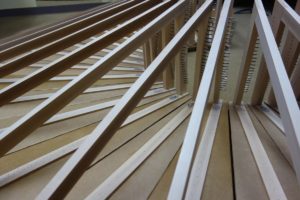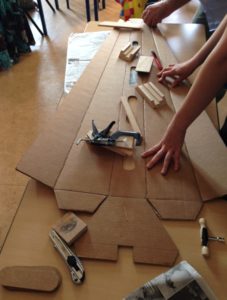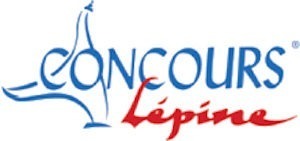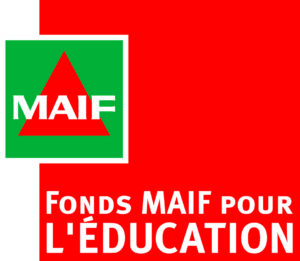 Vous avez dit “popharpes”?
Vous avez dit “popharpes”?
Les harpes en carton de Pop’harpe sont mises au point par Véronique Musson Gonneaud et Pascal Bernard depuis 2010.
En 2016, elles ont obtenu le Prix du Premier Ministre lors du 115e Concours Lépine International de Paris.
Les harpes en carton de Pop’harpe allient sonorité optimale et très bas coût. Le succès de ces instruments tient à la dynamique qu’elles initient : un rapport à la musique basé sur l’échange, la simplicité, l’apprentissage, l’art du compromis et la création.
Elles sont l’instrument d’un projet pédagogique global pour l’accès du plus grand nombre à la harpe : c’est une réponse de musiciens aux défis économiques et sociaux qui se posent aujourd’hui à la pratique musicale.
- On n’achète pas une harpe en carton, on l’assemble soi-même pendant un stage de formation.
- Grâce à leur légèreté (2,5 kg) et leur petite taille (110cm), on peut les emporter partout.
- Chaque harpe en carton est unique : on la décore comme on veut à l’issue du stage.
- Avec leurs 24 cordes (du la 1 au do 5) elles couvrent une large tessiture avec suffisamment de basses pour pouvoir s’exprimer.
- Les demi-tons se font manuellement selon les techniques utilisées au Moyen-Âge.
- Des accords alternatifs avec des cordes ajoutées sont également possibles pour les personnes souhaitant aborder les répertoires des 14e au 16e siècles.
Une création de l’innovation frugale
Au contraire, elles font partie des précurseurs de l’Innovation Frugale dans l’industrie musicale. L’innovation dite « frugale » c’est un mouvement économique qui tente de faire plus avec moins de moyens. Les résultats convaincants apparaissent ainsi aussi rudimentaires que leur conception a été complexe et élaborée. Elles ont été présentées à l’exposition organisée par l’École d’Ingénieurs de Metz en janvier 2017.
Les harpes en carton de Pop’harpe sont le fruit d’une hypothèse audacieuse : pour une sonorité optimale, le calcul du plan de cordes d’une harpe doit primer sur la conception de la caisse de résonance et le travail de lutherie. Par la suite, tout n’est plus que question de recherche d’équilibre, entre théorie et empirisme.
Quel répertoire pour les harpes en carton?
La harpe en carton est avant tout une harpe simple. Par là, elle ressemble aux harpes diatoniques qui ont toujours existé aux côtés d’instruments plus élaborés, tels que les harpes doubles ou triples, les harpes à crochets ou les harpes à pédales (à propos des harpes anciennes). Le répertoire est donc a priori le même que celui des harpes simples historiques.
On connait bien ce répertoire pour les 14e-16e siècles. Et justement, nos harpes en carton ont été conçues sur le modèle des possibilités offertes par les harpes simples de la fin du Moyen-Âge et du début de la Renaissance : elles permettent ainsi d’aborder le même type de répertoire, notamment en musique d’ensemble. En effet, même si les harpes médiévales étaient pourvues de harpions qui faisaient zinguer sensiblement les cordes, l’usage des harpions dans la musique de cette époque n’est pas encore très répandu aujourd’hui. Les harpes en carton ont, de ce fait, une sonorité, un toucher et des possibilités, très proches des harpes « gothiques » telles que les harpistes et luthiers les conçoivent depuis une trentaine d’années. (à propos des harpions)
À partir du 16e siècle, les harpes simples (avec ou sans harpions) ont continué à exister mais on connait encore mal leur répertoire.
Ces instruments étaient plus populaires, plus répandus et certainement plus joués que leurs grandes sœurs élaborées. Limitées par leur diatonisme, les harpes simples n’avaient évidemment pas les mêmes possibilités expressives que les harpes triples par exemple. Pourtant des modèles très différents de harpes ont toujours coexisté. Le répertoire et l’usage des harpes simples constituent selon nous un sujet majeur pour la recherche musicale, musicologique et les applications pédagogiques qui peuvent en être faites aujourd’hui.
Pop’harpe soutient et engage ces recherches. Pour en savoir plus, suivez l’actualité des publications, Rencontres Professionnelles et stages musicaux.
L’usage des harpes en carton aujourd’hui nous oblige à aborder le répertoire à la façon dont le faisaient nos ancêtres et comme le font toutes les musiques vivantes, en tenant compte des limites de l’instrument : avec un art assumé de l’appropriation, l’improvisation, l’adaptation et l’arrangement.
Les harpes en carton conviennent parfaitement bien aux musiques traditionnelles, musiques de tradition orale, musiques actuelles mais aussi aux musiques contemporaines du moment qu’elles ne requièrent pas l’usage structurel des 12 demi-tons !
Des recueils et éditions spécialement destinés aux harpes en carton commencent à voir le jour (par exemple LIEN ARTpublication Agnès + catégories) . Mais ce que nous défendons c’est que chacun, à son niveau, et avec l’instrument qu’il a entre les mains, apprenne à faire ses propres arrangements et adaptations.
Nous développons des outils didactiques et méthodologiques pour cela et orientons, quand c’est possible, les publications dans ce sens avec un souci constant d’ouverture et de clarté.







